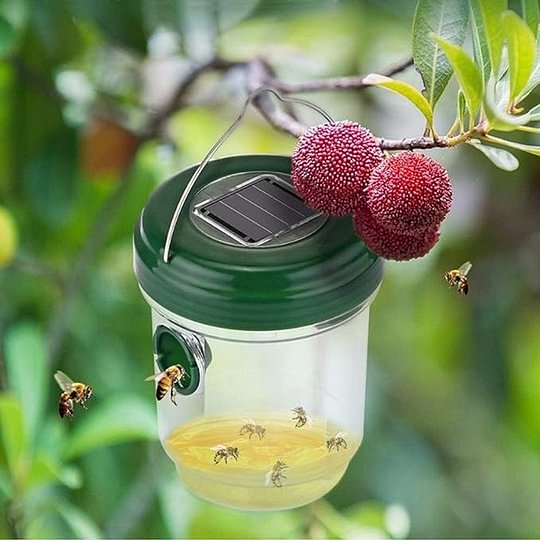As gardeners and homeowners, we often look for efficient and eco-friendly ways to manage the local ecosystem. One creature that can stir both admiration and frustration is the carpenter bee. Known for their distinct buzzing sound and impressive wood-boring abilities, these solitary bees are essential pollinators but can become a nuisance when they invade our wooden structures. However, a creative solution has emerged that not only addresses the carpenter bee issue but also aligns with the growing trend of harnessing renewable energy.
The innovative approach involves developing carpenter bee traps powered by solar energy. These traps utilize solar panels to provide a sustainable power source, making them a perfect fit for environmentally conscious individuals. By integrating renewable energy into pest management, we can effectively trap carpenter bees without relying on harmful chemicals or unsightly traps that detract from our outdoor aesthetics. This method not only benefits homeowners but also promotes the protection of these vital insects, striking a balance between nature and human habitation.
Understanding Carpenter Bees
Carpenter bees are unique creatures that play an important role in our ecosystem as pollinators. They are often mistaken for bumblebees due to their similar size and coloration. However, carpenter bees have a more shiny and hairless abdomen, which sets them apart. They are known for their wood-boring habits, where they create tunnels in untreated wood to lay their eggs, leading to potential damage to wooden structures.

These bees are solitary insects, which means they do not live in colonies like honeybees or bumblebees. Each female carpenter bee constructs her own nesting site and takes full responsibility for raising her offspring. The nesting behavior of carpenter bees can be beneficial for the environment, as they help in the pollination of various plants and flowers, contributing to biodiversity.
Understanding the behavior and habits of carpenter bees is essential for effective pest management. While they are generally not aggressive, their wood-boring activities can cause significant issues for homeowners. Utilizing traps that incorporate solar energy can provide an innovative solution to manage carpenter bee populations while promoting a more sustainable approach to pest control.

Designing Solar-Powered Traps
Creating an effective solar-powered carpenter bee trap begins with selecting the right materials and design. The frame should be sturdy enough to withstand outdoor conditions while also being lightweight for easy placement. Using untreated wood can help make the trap less attractive to carpenter bees, as they are drawn to freshly cut or treated wood. A clear design that incorporates small entry holes can entice bees without allowing them an escape once inside, maximizing the trap's effectiveness.

Integrating solar panels into the design is crucial for powering the trap’s components, such as lights or fans that can aid in attracting or trapping the bees. The panels should be positioned to capture maximum sunlight throughout the day, which means angling them appropriately on the trap. The energy collected can be stored in batteries or directly used to power the trap’s features, ensuring consistent operation without dependency on external power sources.
For additional effectiveness, consider incorporating bee-friendly attractants within the trap. This can include natural scents or visual elements that mimic the bees' preferred habitats. The combination of solar power and these attractive features can significantly increase the likelihood of capturing carpenter bees. By focusing on sustainable and innovative designs, these traps not only serve to manage bee populations but also embrace renewable energy practices that benefit the environment.
Benefits of Solar Energy in Bee Trapping
Utilizing solar energy in bee trapping systems offers significant ecological advantages. By harnessing CARPENTER BEE TRAPS SOLAR ENERGY from the sun, these traps minimize reliance on electricity from traditional power sources. This not only reduces the carbon footprint associated with energy consumption but also aligns with sustainable practices. In turn, this encourages environmentally conscious living, appealing to a growing number of homeowners who are eager to protect both their properties and the planet.
Moreover, solar energy provides a cost-effective solution in the long run. Once installed, solar panels require minimal maintenance and result in lower energy bills, as they utilize free sunlight to power the traps. This economic benefit makes solar-powered carpenter bee traps an attractive investment for individuals dealing with bee infestations. Over time, the savings on energy costs can offset the initial investment, allowing homeowners to efficiently manage pests while also being budget-friendly.
Lastly, solar-powered traps can be placed in remote areas where electrical access may be limited or non-existent. The portability and independence from electrical grids allow these traps to be deployed in gardens, wooded areas, or around outdoor structures. This flexibility enhances their effectiveness, increasing the chances of capturing carpenter bees without disrupting nearby ecosystems. Ultimately, the integration of solar energy in bee trapping represents a harmonious blend of innovation, efficiency, and environmental stewardship.
